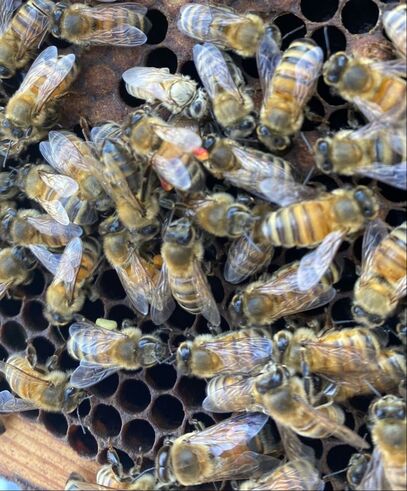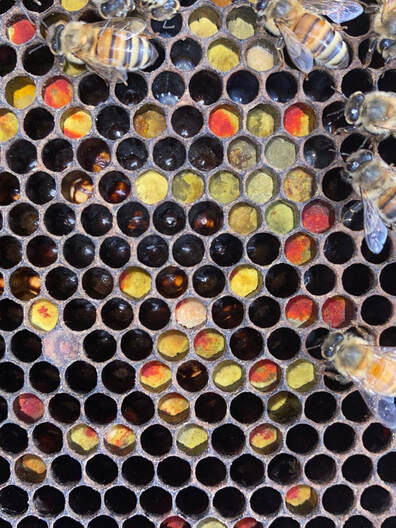By Eric Malcolm
This past Friday, while inspecting colonies on campus, something caught my eye. It reminded me of a refreshing sunrise or perhaps a mixed bit of Play-Doh that my daughter left out: both things I try to keep an eye out for.
It was a special treat that I wanted to share! A rare instance where a honey bee gathered pollen from two different floral sources during its foraging trip. Generally, honey bees practice what is referred to as "floral fidelity." This means they forage from one type of plant at a time. This poses an evolutionary advantage for the plants they visit so they can achieve maximum pollination. However, in some cases, a source will "dry up" or there are not enough flowers of that type to be found, and the forager will change their foraging target.
The red pollen is likely from henbit (Lamium amplexicaule) and the yellow is possibly chickweed (Stellaria media)! You’ll see another bee at the bottom of the frame with dull yellow pollen in her corbiculae (pollen baskets) which is from maple (Acer spp.)
It was a special treat that I wanted to share! A rare instance where a honey bee gathered pollen from two different floral sources during its foraging trip. Generally, honey bees practice what is referred to as "floral fidelity." This means they forage from one type of plant at a time. This poses an evolutionary advantage for the plants they visit so they can achieve maximum pollination. However, in some cases, a source will "dry up" or there are not enough flowers of that type to be found, and the forager will change their foraging target.
The red pollen is likely from henbit (Lamium amplexicaule) and the yellow is possibly chickweed (Stellaria media)! You’ll see another bee at the bottom of the frame with dull yellow pollen in her corbiculae (pollen baskets) which is from maple (Acer spp.)
Springtime is the kickoff to the active part of the beekeeping season. As temperatures rise here in Maryland, our honey bees start being able to fly out to forage for nectar and pollen from flowering plants. As pollen and nectar become more abundant, honey bee colonies begin rapid population growth to prepare. The colony must have enough workers to forage nectar to work it into honey and store for later use in order to survive the coming winter. Queue the big spring buildup!
During this time of the season, foragers gather pollen and nectar from a variety of plants in order to feed a large amount of offspring. Fascinatingly, honey bees actively manage what pollen is foraged to meet their specific nutritional needs. If there is a pollen with low nutritional value (like that from roses), they will change plants when other options become available to adjust for deficiencies!
During this time of the season, foragers gather pollen and nectar from a variety of plants in order to feed a large amount of offspring. Fascinatingly, honey bees actively manage what pollen is foraged to meet their specific nutritional needs. If there is a pollen with low nutritional value (like that from roses), they will change plants when other options become available to adjust for deficiencies!



 RSS Feed
RSS Feed